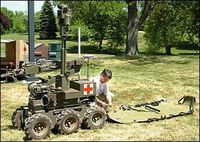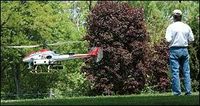Robots in the Military Today
Military Robots Demonstrated
Cutting-edge robotics head for battle
By Kristin Wilson, May 19, 2005
Examples of just some of the cutting-edge technologies that are making their way onto today's battlefields were on display Wednesday at Carlisle Barracks. The aerial, ground and bunker-hole devices all have similar missions — to defeat enemy forces while minimizing casualties to American troops.
Roadside ambushes
"Every day in Iraq, you hear about roadside ambushes," says Air Force Lt. Col. Steve Ward. That's why the Air Force's Unmanned Aerial Vehicle Battlelab is working to get lighter, more mobile and easy to use "Unmanned Aerial Vehicles" (UAVs) to accompany convoy units.
Robotic Evacuation Vehicle
The U.S. Army is developing a way for robots to detect and protect wounded soldiers in the field.
Members of the U.S. Army Tank-Automotive Research, Development and Engineering Center (TARDEC) and the Telemedicine and Advance Technology Research Center are working on robotic teams that will be able to find downed soldiers and protect them while a field medic gets to the scene.
Robert Watts of TARDEC explains the robotic version of a Red Cross van will roll into a field and send off a smaller robot capable of detecting human life.

Robot Medic
"It has sensors that can detect wounded individuals. It can identify respiratory and heart rate," says Watts. The robot can also cover a soldier with a "ballistic blanket" for further protection.
Explosive Disabler Robot
Experiences with explosive devices in the Middle East prompted defense contractors to come up with a robot that can examine and potentially disable bombs.
The Foster-Miller company robot — TALON — is the main platform for the specialized system that allows Explosive Ordinance Disposal (EOD) soldiers to investigate a suspicious item from a secure, remote location, explains Dave Kowachek of TARDEC.
A bomb defuser is attached to the robot so that an explosive device can be eliminated, minimizing damage to the surrounding area. This type of technology is especially important when a bomb is discovered on a bridge or urban area, where it would not be possible to detonate the devise safely, Kowachek says.
Helicopter Surveillance Robot
For 15 years a dedicated team of researchers at Carnegie Mellon University have developed a highly intelligent, unmanned, autonomous helicopter that can map terrain or chase a target.
Like an unmanned aerial vehicle (UAV), the helicopter's advantage is providing a bird's eye view of unknown territory. However, a helicopter model has specific advantages, says Dr. Omead Amidi, a research faculty member at the university.
"A helicopter is good because it can stop. When you can stop, you can look around, you can chase someone," he says. It is also easier to change altitudes, take off and land. The Carnegie Mellon helicopter system doesn't require a person to be on the ground to help with takeoff or landing.

Army Helicopter Robot
In fact, the helicopter doesn't require any manning at all. While a remote-control option is available, the helicopter's computer system can be programmed to complete a mission without any human interaction.
The Carnegie Mellon team developed intelligence that programs helicopters to "follow" unique or specialized objects it comes across.
The Sentinel Online - Archived Story
Cutting-edge robotics head for battle
By Kristin Wilson, May 19, 2005
Examples of just some of the cutting-edge technologies that are making their way onto today's battlefields were on display Wednesday at Carlisle Barracks. The aerial, ground and bunker-hole devices all have similar missions — to defeat enemy forces while minimizing casualties to American troops.
Roadside ambushes
"Every day in Iraq, you hear about roadside ambushes," says Air Force Lt. Col. Steve Ward. That's why the Air Force's Unmanned Aerial Vehicle Battlelab is working to get lighter, more mobile and easy to use "Unmanned Aerial Vehicles" (UAVs) to accompany convoy units.
Robotic Evacuation Vehicle
The U.S. Army is developing a way for robots to detect and protect wounded soldiers in the field.
Members of the U.S. Army Tank-Automotive Research, Development and Engineering Center (TARDEC) and the Telemedicine and Advance Technology Research Center are working on robotic teams that will be able to find downed soldiers and protect them while a field medic gets to the scene.
Robert Watts of TARDEC explains the robotic version of a Red Cross van will roll into a field and send off a smaller robot capable of detecting human life.

Robot Medic
"It has sensors that can detect wounded individuals. It can identify respiratory and heart rate," says Watts. The robot can also cover a soldier with a "ballistic blanket" for further protection.
Explosive Disabler Robot
Experiences with explosive devices in the Middle East prompted defense contractors to come up with a robot that can examine and potentially disable bombs.
The Foster-Miller company robot — TALON — is the main platform for the specialized system that allows Explosive Ordinance Disposal (EOD) soldiers to investigate a suspicious item from a secure, remote location, explains Dave Kowachek of TARDEC.
A bomb defuser is attached to the robot so that an explosive device can be eliminated, minimizing damage to the surrounding area. This type of technology is especially important when a bomb is discovered on a bridge or urban area, where it would not be possible to detonate the devise safely, Kowachek says.
Helicopter Surveillance Robot
For 15 years a dedicated team of researchers at Carnegie Mellon University have developed a highly intelligent, unmanned, autonomous helicopter that can map terrain or chase a target.
Like an unmanned aerial vehicle (UAV), the helicopter's advantage is providing a bird's eye view of unknown territory. However, a helicopter model has specific advantages, says Dr. Omead Amidi, a research faculty member at the university.
"A helicopter is good because it can stop. When you can stop, you can look around, you can chase someone," he says. It is also easier to change altitudes, take off and land. The Carnegie Mellon helicopter system doesn't require a person to be on the ground to help with takeoff or landing.

Army Helicopter Robot
In fact, the helicopter doesn't require any manning at all. While a remote-control option is available, the helicopter's computer system can be programmed to complete a mission without any human interaction.
The Carnegie Mellon team developed intelligence that programs helicopters to "follow" unique or specialized objects it comes across.
The Sentinel Online - Archived Story
Labels: EOD, military robots

0 Comments:
Post a Comment
Subscribe to Post Comments [Atom]
<< Home